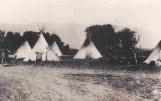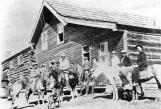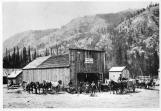1
The Kettle River Valley near MidwayCirca 1890
The Boundary
 Credits:
Credits:William C. Mitchell collection
Kettle River Museum
2
Imagine it's the end of the 19th Century in the Boundary region of southern British Columbia and the sound of hoof-beats is beginning to fill the air once more - wagon wheels too.Life hadn't changed much in the centuries before the discovery of gold in Rock Creek near the Kettle River in 1860, when the gold rush brought a steady steam of miners and entrepreneurs.
Most were Americans. Access to the Boundary was easier for them than Canadians, between mountain ranges that run north and south. Then the gold rush ended within a few years and Rock Creek became an all but deserted camp. The Kettle River flowed on as before, through a beautiful but unpopulated land.
Sounds of change are in the air again...
3
Travelling on the Dewdney Trail near HopeThe Dewdney Trail, BC
 Credits:
Credits:Penticton Museum & Archives
4
Edgar Dewdney and his survey team were contracted to blaze a trail through the wilderness of southern BC, from Fort Hope in the West to Fort Steele in the East - the Dewdney Trail. Access to the rest of Canada was now possible but there were few who needed it.In an interview by Percy F. Godenrath in 1901, Dewdney said, "The nature of the county as far eastward as Eholt's ranch [now Midway on the Kettle River] was mostly rolling hills and valleys, heavily covered with bunch grass and inhabited by Indians. Rock Creek was already a deserted camp except for a few Chinamen.
Eastward from Eholt's ranch the trail followed the meandering of Boundary Creek, crossing over to the North Fork of the Kettle River. On reaching this creek I decided to explore east, and came out at the Arrow Lakes."
6
The gold rush brought a few permanent settlers to the Boundary. Cattlemen who had driven livestock in to feed the miners stayed and claimed title to the valley's rich grasslands.Since the survey of the Canada/US border had been completed the area's First Nation people were based south of the border on the Colville reservation, but continued to venture north in large hunting parties to their traditional big game hunting grounds.
And by the 1890's a new mineral boom was underway. Silver mining in the Kootenays had begun. Then discovery of rich copper deposits in the Boundary came next. With the advent of electricity there was no end in sight to the market for copper wiring - the rush was on again!
Beaverdell, Brown's, Burnt Basin, Central, Copper, Deadwood, Franklin, Graham's, Greenwood, Kimberley, Long Lake, McKinney, Phoenix, Providence, Skylark, Smith's, Summit, Triple Lakes and Wellington. By the end of the 19th Century 19 mining camps had been established in the Boundary.
7
By the end of the 19th Century there were 19 mining camps1967
The Boundary
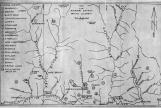 Credits:
Credits:Boundary HIstorical Society 5th Report, 1967
8
Travel to and from the Boundary for the new settlers was still long and arduous."In the spring of 1890 father returned to Kamloops and on June 25th married Miss Agnes B. Tannahill, a native of Scotland... After purchasing a team, wagon and other necessary equipment for their new home, they proceeded to Mission (now Kelowna) where everything but the horses were loaded on an Indian scow to be transported down Okanagan lake. Father and Mother rode the horses down the east side of the lake and met up with the Indians and their wagon at what is now the city of Penticton.
They loaded their wagon and headed south through the Okanagan Valley to what is now the village of Osoyoos. Here it was necessary to ford the lake at that narrow neck of land, and proceed over Anarchist mountain to the Kettle River valley. They reached their new location after traveling many miles over bad roads, trails and numerous swollen streams."
- from "By Wagon: Kamloops to the John Robert Jackson Ranch", a Jackson family memoir. Boundary Historical Society 4th Report, 1964.
9
Passing through Rock Creek to the Kettle River Valley1890
Rock Creek, BC
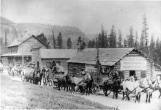 Credits:
Credits:Kettle River Museum
10
"The first stages were just wagons with a seat up front for the driver. Passengers and freight rode in the back... Passengers were known as 'stagers' and came in three classes: first class was ladies who got to sit up front with the driver, second class had to get out and walk up hills and the third class passengers had to get out and push!Passengers traveling from Penticton to Grand Forks and beyond left Penticton at 7:00 a.m. each Tuesday on Johnson's Express Line... They would reach Camp McKinney at 7:00 p.m.
Next morning it was on to Midway via Rock Creek. The route was up the Dewdney Trail to the area known as the Summit, then to the International Boundary Line and on to the Grand Prairie (now Grand Forks)- a journey of another two or three days."
- from "To the Boundary by Stage" by Rose M. Gobeil, Boundary Historical Society 12th Report, 1992.
12
Canadian Pacific Railway's first cross-Canada through train1885
unknown
 Credits:
Credits:Library and Archives Canada - C-014464
13
Transport and travel to and from the Boundary improved considerably when the Canadian Pacific Railway Company opened its cross-Canada mainline in 1885. Travellers would still leave the Boundary by wagon and stage, but their destination was to Okangan Lake, where they could board barges and sternwheelers for the north end of the lake, and on to the CPR line at Sicamous."In July 1893 father journeyed again to Chilliwack to be married to Elida Casselman. The wedding was at six a.m. so that the newlyweds might board the Canadian Pacific train at Agassiz en route to Kamloops. From there they went by stagecoach to Vernon by way of Westwold.
Here started the real pioneer life; they were met by a freight wagon drawn by a four-horse team. The wagon was loaded with furniture, a year's supply of food, and on top a cradle, which I later enjoyed. My mother claimed to have walked most of the way up the mountain to Camp McKinney and down to Rock Creek. On the up-grade my mother said she lightened the load and on the down-grades she was afraid to ride perched high on the freight wagon. The 'road' was a trail."
- from "Robert Duncan Kerr" by Alice Kerr MacMillan, Boundary Historical Society 4th Report, 1964
The mining camps flourished. Communities grew to become supply centres and residential communities. Agriculture and the lumber industry grew too.
